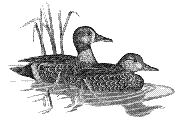United States Fish and Wildlife Service

Waterfowl Management Handbook
Date of this Version
January 1990
Abstract
Glaciated wetlands of the prairie pothole region are among the most productive of ecosystems. In terms of primary productivity (vegetation) they rank with the tropical rain forests (Fig. 1). Wetland productivity is controlled by water levels that fluctuate over time. However, primary productivity is highly variable for a variety of reasons including the variance in annual precipitation, the nature of the glacial till, the salinity of the water, the relation of the basin to the groundwater, and the temperature extremes typical of a continental climate.
My purpose is to review the basic patterns that contribute to the productivity of prairie wetlands with the goal of duplicating some of the essential ingredients in managed marshes. The most effective strategy for meeting this goal is through community management. This requires a basic understanding of the dynamics of the marsh ecosystem.


Comments
Published in Diana H. Cross and Paul Vohs (eds.) Waterfowl Management Handbook. Fort Collins, CO: U.S. Fish and Wildlife Service, 1988. Online at http://www.nwrc.usgs.gov/wdb/pub/wmh/contents.html